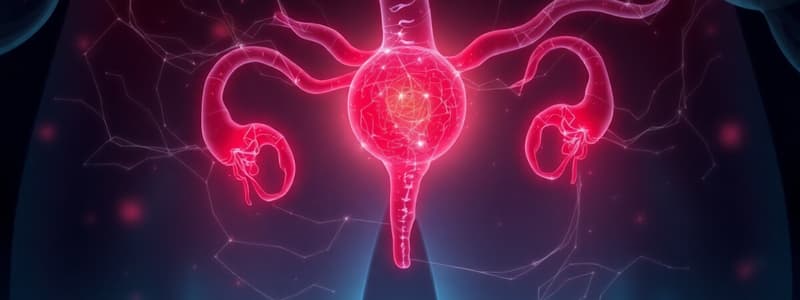Podcast
Questions and Answers
Which condition is characterized by leakage of urine during increased intra-abdominal pressure?
Which condition is characterized by leakage of urine during increased intra-abdominal pressure?
- Detrusor Overactivity
- Overflow Incontinence
- Stress Urinary Incontinence (correct)
- Overactive Bladder
What investigation is most useful for tracking patterns in bladder function?
What investigation is most useful for tracking patterns in bladder function?
- Urodynamic Testing
- Urinalysis
- Cystoscopy
- Bladder Diary (correct)
Which muscle is responsible for voluntary control of urinary retention?
Which muscle is responsible for voluntary control of urinary retention?
- Internal Urethral Sphincter
- External Urethral Sphincter (correct)
- Bladder Wall Muscles
- Detrusor Muscle
In the context of the micturition cycle, sympathetic nervous control primarily serves what function?
In the context of the micturition cycle, sympathetic nervous control primarily serves what function?
What is the hallmark feature of overflow incontinence?
What is the hallmark feature of overflow incontinence?
What is the primary role of the lower urinary tract?
What is the primary role of the lower urinary tract?
Which muscle is responsible for the contraction during micturition?
Which muscle is responsible for the contraction during micturition?
What type of control does the internal urethral sphincter provide?
What type of control does the internal urethral sphincter provide?
What phase of the micturition cycle occurs over 98% of the time?
What phase of the micturition cycle occurs over 98% of the time?
Which treatment option is suggested for managing detrusor overactivity?
Which treatment option is suggested for managing detrusor overactivity?
What diagnostic test is commonly used to assess the coordination between detrusor contraction and sphincter relaxation?
What diagnostic test is commonly used to assess the coordination between detrusor contraction and sphincter relaxation?
Which component of the nervous system is NOT directly involved in controlling the micturition cycle?
Which component of the nervous system is NOT directly involved in controlling the micturition cycle?
What complication can result from incomplete bladder emptying?
What complication can result from incomplete bladder emptying?
Flashcards
Micturition
Micturition
The process of actively voiding urine from the bladder.
Detrusor Muscle
Detrusor Muscle
The smooth muscle of the bladder wall that contracts to help void urine.
Internal Urethral Sphincter
Internal Urethral Sphincter
An involuntary, smooth muscle sphincter at the bladder neck, controlling the flow of urine.
External Urethral Sphincter
External Urethral Sphincter
Signup and view all the flashcards
Micturition Cycle
Micturition Cycle
Signup and view all the flashcards
Voiding Phase
Voiding Phase
Signup and view all the flashcards
Storage Phase
Storage Phase
Signup and view all the flashcards
Detrusor Overactivity
Detrusor Overactivity
Signup and view all the flashcards
Stress Urinary Incontinence (SUI)
Stress Urinary Incontinence (SUI)
Signup and view all the flashcards
Overflow Incontinence
Overflow Incontinence
Signup and view all the flashcards
Study Notes
Lower Urinary Tract Overview
- The lower urinary tract (LUT) is responsible for urinary storage, voiding, and protection from infection.
- It comprises the bladder and urethra.
- The LUT is controlled by a complex neural system in the lower pelvis.
- The micturition cycle alternates between storage and voiding phases. Storage takes up 98% of the time.
Learning Objectives
- Define the lower urinary tract and its functions.
- Describe the urinary sphincter unit.
- Illustrate the neural control of the LUT.
- Explain the micturition cycle.
Key Concepts and Definitions
- Lower Urinary Tract (LUT): Composed of the bladder and urethra, responsible for urine storage, voiding, and protection from infection.
- Micturition: The process of voiding urine from the bladder.
- Detrusor Muscle: The smooth muscle of the bladder wall that contracts to void urine.
- Internal Urethral Sphincter: An involuntary smooth muscle sphincter at the bladder neck.
- External Urethral Sphincter: A voluntary striated muscle sphincter controlling urine release from the bladder.
Clinical Applications
- Case Study: A patient with detrusor overactivity experiences incontinence due to difficulty deferring the urge to void.
- Diagnostic Approach: Urodynamic testing assesses coordination between detrusor contraction and sphincter relaxation.
- Treatment Options: May include behavioral training (bladder training) and medications (antimuscarinics).
- Complications/Management: Incomplete bladder emptying can lead to urinary retention and recurrent UTIs
Pathophysiology
- Pathway/Mechanism: The micturition cycle is controlled by central and peripheral nervous systems, switching between storage and voiding.
- Diagram: A diagram illustrating the roles of parasympathetic, sympathetic, and somatic control in the micturition cycle is needed.
Pharmacology
- Antimuscarinics: Reduce detrusor overactivity, used to treat overactive bladder.
- Beta-3 Adrenergic Agonists: Relax the detrusor muscle, promoting bladder filling and increasing storage capacity.
Differential Diagnosis
- Overactive Bladder: Urgency with or without incontinence, often due to detrusor overactivity.
- Stress Urinary Incontinence (SUI): Urine leakage during increased intra-abdominal pressure.
- Overflow Incontinence: Occurs when the bladder does not fully empty, leading to dribbling.
Investigations
- Urodynamic Testing: Measures bladder pressure, capacity, and function.
- Bladder Diary: Tracks voiding patterns to identify bladder function issues.
- Urinalysis: Examines urine to detect infections, hematuria, and other abnormalities.
Summary and Key Takeaways
- The LUT has two main functions: urine storage and voiding
- The micturition cycle involves a switch controlled by sympathetic, parasympathetic, and somatic nervous systems.
- Key muscles involved include the detrusor, internal and external urethral sphincters.
Studying That Suits You
Use AI to generate personalized quizzes and flashcards to suit your learning preferences.




